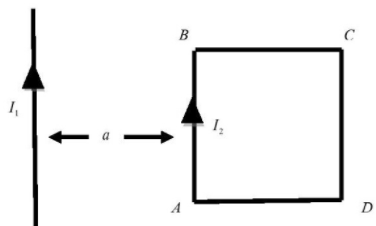
A square loop of a side ‘a’ is placed at ‘a’ distance away from a long wire carrying a current

Answer
196.5k+ views
Hint: The concept of the Left-hand rule can be used to solve this problem. When a current-carrying conductor/wire is placed in a magnetic field, a force is exerted on the wire.
Hence Fleming gave a simple rule to determine the direction of force acting on a current-carrying conductor/wire placed in a magnetic field. This can be used to calculate the force of nature.
Complete step by step answer:
If the direction of electric currents flowing in two parallel straight conductors is the same then they will attract each other.
If the direction of electric currents flowing two parallel straight conductors are opposite then they repel each other.
In this question, current
So current
Or,
So force per unit length than the two wires exert on each other is,
Hence
The answer will be
Note: The strong force of nature is considered as the most powerful force. The electric, weak, and gravitational forces are followed in decreasing order.
Despite its strength, because of its exceedingly small range, the strong force does not manifest itself in the macroscopic universe.
When a current-carrying wire is placed in a magnetic field of another current-carrying wire, it experiences a magnetic force.
The direction of the force depends on the direction of the magnetic field as well as the current and is perpendicular to it.
Hence Fleming gave a simple rule to determine the direction of force acting on a current-carrying conductor/wire placed in a magnetic field. This can be used to calculate the force of nature.
Complete step by step answer:
If the direction of electric currents flowing in two parallel straight conductors is the same then they will attract each other.
If the direction of electric currents flowing two parallel straight conductors are opposite then they repel each other.
In this question, current
So current
Or,
So force per unit length than the two wires exert on each other is,
Hence
The answer will be
Note: The strong force of nature is considered as the most powerful force. The electric, weak, and gravitational forces are followed in decreasing order.
Despite its strength, because of its exceedingly small range, the strong force does not manifest itself in the macroscopic universe.
When a current-carrying wire is placed in a magnetic field of another current-carrying wire, it experiences a magnetic force.
The direction of the force depends on the direction of the magnetic field as well as the current and is perpendicular to it.
Latest Vedantu courses for you
Grade 6 | ICSE | SCHOOL | English
Vedantu ICSE 6 Pro Course (2025-26)
School Full course for ICSE students
₹28,100 per year
Recently Updated Pages
JEE Main Course 2026 - Important Updates and Details

JEE Main 2022 (July 26th Shift 1) Physics Question Paper with Answer Key

JEE Main 2022 (June 26th Shift 2) Chemistry Question Paper with Answer Key

Apparent Frequency Important Concepts for JEE Main

JEE Main 2023 (January 30th Shift 2) Chemistry Question Paper with Answer Key

JEE Main 2023 (April 15th Shift 1) Physics Question Paper with Answer Key

Trending doubts
JEE Main 2025 Session 2: Application Form (Out), Exam Dates (Released), Eligibility, & More

Equation of Trajectory in Projectile Motion: Derivation & Proof

Atomic Structure: Definition, Models, and Examples

Hybridisation in Chemistry – Concept, Types & Applications

Angle of Deviation in a Prism – Formula, Diagram & Applications

Collision: Meaning, Types & Examples in Physics

Other Pages
JEE Advanced Marks vs Ranks 2025: Understanding Category-wise Qualifying Marks and Previous Year Cut-offs

JEE Advanced Weightage 2025 Chapter-Wise for Physics, Maths and Chemistry

How to Convert a Galvanometer into an Ammeter or Voltmeter

Average and RMS Value in Physics: Formula, Comparison & Application

Degree of Dissociation: Meaning, Formula, Calculation & Uses

Wheatstone Bridge Explained: Principle, Working, and Uses




